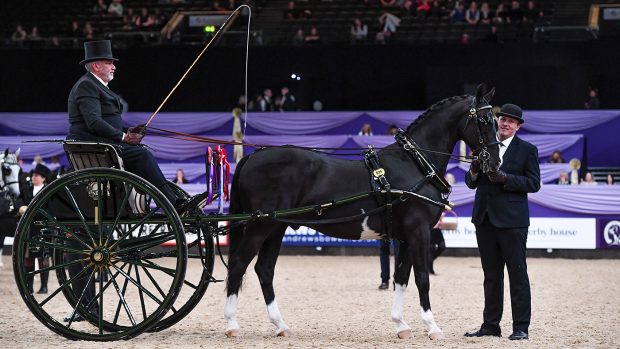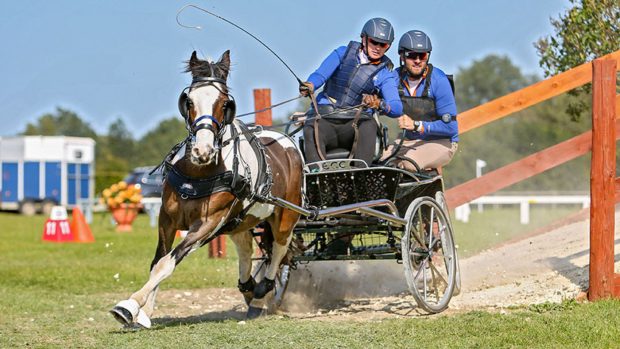There has been quite a bit of discussion on carriage driving forums lately about the difficulties driving horses face in freeing up their movement when pulling a carriage.
Much of this discussion focuses on dressage, and in particular collected trot, but it highlights a common problem. A harness horse necessarily has the drag factor of a carriage impeding its forward action and its movement can be further restricted by the harness.
Since the horse pushes against the collar in order to pull the carriage it is clearly very important that this is fitted correctly and gives a good bearing surface to allow for the weight of the vehicle and — especially when considering the quality of the horse’s movement — that the shoulder can move freely.
There are excellent articles on the effect of the line of draught so that is not my intended focus — though it plays an important part in how balanced the horse is and its subsequent way of going.
Harness is a fascinating subject that fills entire books so this blog merely touches on aspects which can then be more fully referenced by an interested reader.
As the collar plays such a key role it is very useful to be aware of the different collar options for the harness horse. It can seem a bewildering choice for the newcomer to driving. Collars fall into two main types — full collars and breast collars with many variations of each.
Full collars

A correctly fitted full collar allows the greatest freedom of movement as there is no restriction across the chest or shoulder. It is also the most efficient way to pull heavy weights and is used for coaching horses, and specialised versions are favoured as draft horse collars. Full collars are widely seen in the show ring in private driving classes where extravagant movement, as well as traditional harness, is favoured. These are often of an elegant, swept back design and made of black patent with gleaming brass hames.
For country vehicles a brown harness and collar are considered correct. Full collars and traditional harness are often favoured for the dressage phase of FEI horse driving trials.
However it is crucial that these fit correct to avoid pinching or rocking and rubbing.
Breast collars are more popular for driving as they can easily be adjusted to fit the changing shape of the horse over the season and also to fit different horses.
As with full collars it is essential not to obstruct the windpipe or the horse will struggle to breathe when in draught. Breast collars are much easier to put on the horse, whereas a full collar presents a small opening and is put over the horse’s head with the widest point over the eyes and then must be carefully turned once on the neck.
Breastcollars

The disadvantage of the breast collar is that it is a weight pulling strap across the horse’s chest which puts pressure on this key area. Breast collars are therefore used for lighter carriages such as exercise vehicles and modern four-wheelers. Chest straps should be soft or well padded.
A wide chest strap spreads weight and eases pressure, but can push on the windpipe or sit too low to be comfortable over the shoulder. Where the breast collar passes in the line of draught to the traces it can impede the shoulder movement and leg action. The traces of a breastcollar harness must be attached to a swingletree on the carriage that will move with the horse’s action or very quickly the friction of the harness moving across the horse’s skin builds up soreness. A breast collar fitted too low will cause great restriction of movement.
Other collars available

Due to the conformation of certain breeds and certain horses it can be very difficult to get a breast collar fit that allows unrestricted breathing yet sits above the point of shoulder to allow free movement. This has led to the development of shaped breast collars such as empathy collars (pictured) which are very popular in horse driving trials.
On the most up-to-date designs the trace buckle fits on a ring which allows the traces to slope down to the low swingletrees of modern sports carriages without forcing the collar up at the front. The design is cut high over the shoulder to ease restriction of this key area. On older designs it is important to make sure the more rigid line of draught does not force the top edge of the collar into the chest.

Another popular collar widely seen in horse driving trials and distance driving is the brollar (pictured above and top) or eurocollar. There are many variants and styles have greatly improved over the years to minimise heat retention.
Correctly fitted, the Brollar lies neatly round the horse’s neck and shoulders and combines all of the positive aspects of both harness types. The cut out in the area of the shoulder joint ensures a very comfortable position on the horse with maximum shoulder movement. It also maximises pulling power and for this reason my Welsh section C finds this collar very helpful for hill work, especially across country in the marathon phase.
As with any part of a harness it cannot be stressed enough how important it is to ensure a good correct fit and cleanliness to avoid fiction and soreness.
Old sweat as well as dirt should be cleaned off the inner surfaces. Draft collars are usually lined with wool or serge to absorb sweat which should be thoroughly dried and brushed.
Leather linings should be cleaned appropriately. The joy of modern materials is they are light, robust and easy to clean. Most synthetic harness can simply be thoroughly hosed of.
There are excellent guides and books on harness fitting and more information on the fascinating subject of horse collars. Advice from a qualified harness fitter or instructor is readily available if you wish to check the set up you are currently using.
Emily




